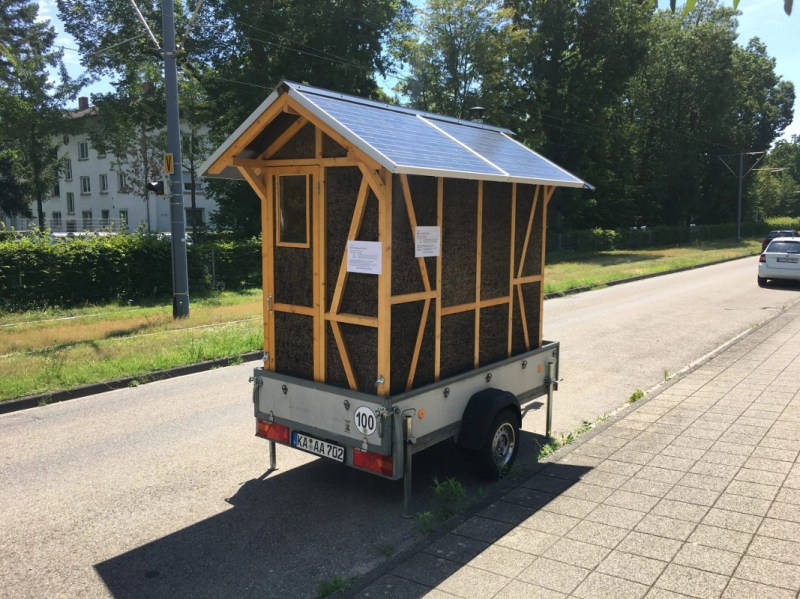While it might be nice to imagine owning a cabin in the woods to escape from society, complete with an outdoor sauna to take in the scenic views of nature, most of us will be satisfied with the occasional vacation to a cabin like that. For those trips, or even for long-term camping trips, [Schitzu] and a group of friends thought it would be nice to be able to ensure access to a sauna. For that, they created this mobile, timber-framed sauna that he can tow behind his car.
The sauna is built out of a combination of spruce and Douglas fir, two types of lumber with weather-resistant properties. For an additional layer of protection, the frame was varnished after assembly. The walls are filled with baked cork for insulation, and heat is provided by a small wood-fired oven placed in the corner of the sauna with a stove pipe plumbed through the roof. Performance of the sauna shows good design too, as it can heat up quickly and performs well in all of the tests so far. The final touch on the mobile sauna was to finish the roof with some solar panels in order to gather some energy for long-term camping trips and also to ensure that the roof was protected from rain and weather.
The sauna is designed for two adults to sit in, but it will also accommodate a single person to lay down and sleep (presumably when not using it as a sauna), so the entire trailer actually makes a fairly capable mobile camper too. With the addition of a panoramic window, anyone can take in the sights as well as someone with their own permanently-located sauna could, which is a win in all of our books. If you’re looking for a mobile sauna that’s a little more discrete though, be sure to check out this one which is built in the back of a white panel van.















There’s a whole category of tent saunas that are also quite handy. These are usually military style canvas tents with folding wooden benches inside, but there are also portable sweat lodges modeled after yurts and other styles. A sauna doesn’t strictly need insulation of any sort to work, as long as you have walls to contain the hot humid air. It works fine in the winter as well.
A simple version:
https://varuste.net/tiedostot/1/kuva/tuote/1920/o12741962.jpg
One could in principle also make a fold-out sauna with one wooden wall with a door, a window, and a long bench that fixes to the wall and keeps it upright. All the rest can be made out of sticks and canvas. This construction could be laid flat on the trailer for easier transport, it would weigh less, and fit more stuff along for the ride.
You can find alot of these in finland. Just google: peräkärrysauna
Never the less, a neat build!
I looked at the pictures and all I can see is exhaust stack but no intake for the stove. If makeup air has to get into such a small space how does it stay warm enough? This negates the cork insulation or it only helps a little. Better to have an outside air intake port like is often done in homes that are tightly insulated, then it can get nice and steamy.
The actual post explains it quite well. The air intake is underneath the stove, drawing fresh air in as hot air rises out. It appears that rocks on top are essentially the heat exchanger. The article also makes it clear the builder is at least confident, or more likely quite familiar, with the construction of proper saunas, everything was well explained and well reasoned. They even avoided gluing the cork insulation material on as would be usual, to avoid adhesive breakdown from sauna conditions, instead using rabbets to mechanically hold things in place.
More precisely, the cool air rises in through the jacket of the stove, gets heated, and circulates inside the sauna before getting ingested by the fire.
This results in very efficient heating, but a rather dry sauna with short sharp heats from the steam, as opposed to a long mellow steam of a more traditional sauna that doesn’t use the fireplace like a hot air gun. This sort of a sauna is more for getting your back prickling hot and your ears stinging, then running off into the icy lake and back again, as opposed to leaning back and relaxing with a towel on your forehead, but, both are possible if you restrict the air intake (after the fire has died down so you don’t asphyxiate yourself).
There are as many styles as there are builders.
Thanks for this insightful reply, that makes me wanna add an air restrictor to air inlet now. What diameter would you suggest for when the fire has died down?
-schitzu (the builder)